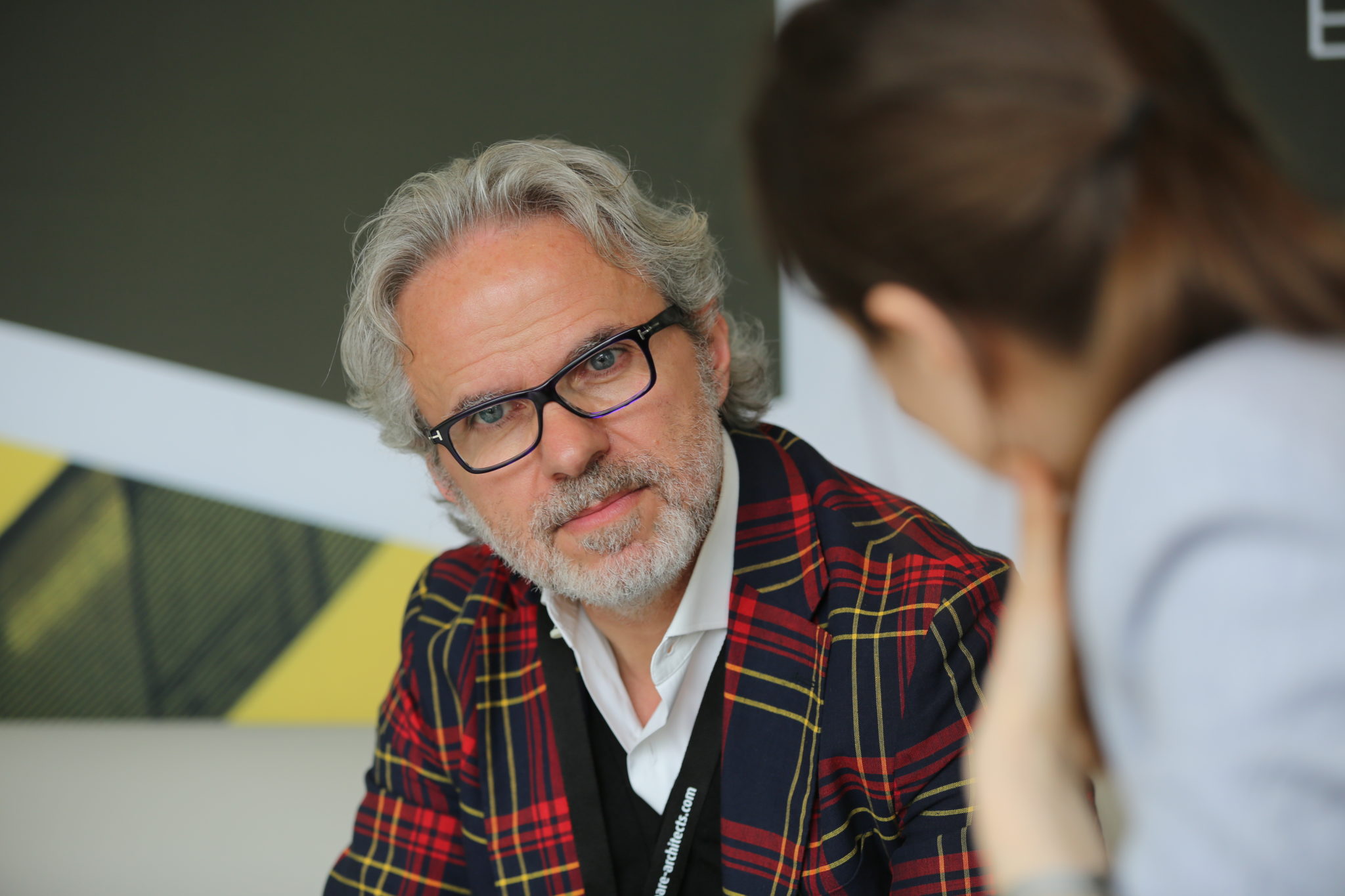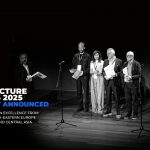In Dialogue with ALFONSO FEMIA
“The thing that I find interesting about architecture is talking to people, in a spatial language, about their reality (…) . It is a whole journey in the mind of the architect.”
Alfonso Femia: The thing that I find interesting about architecture is talking to people, in a spatial language, about their reality – I think this is the first important rule of architecture. I believe in the human dimension of the profession and I think it is one of the last fields that involve the changing relationships between people. So in every action or project we make we have to try to pursue these elements. At the same time, I feel that architecture is devoted to feelings and it creates an emphatic way of discovering and understanding the questions that have to be answered. I don’t believe architecture is a way of declaring ‘This is the truth!’ especially in today’s open world. I think there is a new sensibility where this approach is viable and more recent. When I talk in this way people tell me I am romantic but this is not a question of romance because when we’re talking about feelings in the fields, there is a whole sentiment – not only love, but responsibility and vision. As I said, it is a whole journey in the mind of the architect.
Andreea Movila, publisher www.share-architects.com: Can you depict your journey in mind?
Alfonso Femia: The journey enables seeing the reality in different ways and constantly changing the perspective when seeing the same things. Today the journey means a way of meeting new possibilities and visions but in the past the journey caused some contamination.
A.M: How did you manage to invest your work with your own ideas and visions?
A.F: Totally! If I invest in a team and allow it to create a dialogue with a client, I must believe in their different ways of thinking. If the work is only about one profession, then my contribution is not necessary anymore. We make our visions and imagination reality and in this way architecture is a very strong medium for culture to strive and for better future prospects.
A.M: What moment in your career had a great impact on the architect you are today?
A.F: I think that was my first project that made me understand I could make architecture very emphatic and valuable without a big budget or a very clear question. We introduced this idea of generosity in our projects and managed to create a large vision that people could understand. We must always have a guide towards a big vision because all the work is translated into reality. Architecture is translating the words and feelings into reality – this is the best way of making people understand architecture. Another moment that had a great impact was finishing Les Docks de Marseille because we tried to reintroduce the idea of sensibility over the Mediterranean area with the materials, the artists’ works, the art and craftsmanship and with the industry. The major problems with architecture projects are time and budget but that doesn’t mean that good architecture isn’t possible. We must give our generosity and expand our vision – this is becoming more and more important.
A.M: What is the role of the architect today? How has this role changed during time?
A.F:Architects have the same goals no matter the period of history. Architect is connected to the reality, the imaginary and the culture, things that make him a humanist.
A.M: So the image of the architect has remained the same?
A.F: Yes! The rules and methods changed, but his job is really the same. Today it is a bit more difficult because there is a long process that cannot be followed from beginning until the end. However, there are a lot of possibilities to learn and understand certain topics and it is easier to concentrate ones capacity in that way. Architecture is not only about drawings and technical solutions – it is about the whole process and dialogue in general.
A.M: The process is as important as the final result.
A.F: Absolutely! Perhaps the architect has to be capable to put all this mess into one single vision.
A.M: Is he intended to make the complexity clear?
A.F: Complexity is interesting in a way that we must see the difference between ‘complex’ and ‘complicated’. If something is complex it becomes interesting, but if it’s complicated, that means something doesn’t work.
A.M: Complexity is the sum of all possibilities and potential solutions.
A.F: This is valid today because we are working in two separate times simultaneously – the era of speed where everybody can solve problems quickly and a slow pace that enables curiosity and discovery. Only doing things on the schedule is not enough because they have no essence and you can never accomplish anything like that. This is the complexity of the contemporary times.
A.M: Will the field become more complex in the future?
A.F: Absolutely!
A.M: As it becomes more complex, will architects be able to cope with all this complexity? . Today we already have lighting or landscape architects – or as some sais, many parts of the field have already been taken by other professionals and the architect has been left only with the concept.
A.F: I don’t believe in a vision where we are dependent on the addition of people specialised in different fields. I think there is a necessity to have them but this is alright only if we manage to be at the core of the team and look for one vision. This multiplication is sometimes a way of not putting the real questions on the table and find the answers. Architects need to become more flexible because there is a very strong responsibility for them. I believe in architecture because it doesn’t engage only architects – before beauty and the aesthetics architecture is a matter of feeling.
A.M: I am fascinated by the fact that architecture is not only about “architects” anymore. In computer science we have the notion of software architect – an architect who manages information for a final product, like an app. We are in a certain way architects of information because we operate with some data and have a built output.
A.F: Architecture is made up of two elements: arkhi and tekton. The last one refers to building and technology because architecture relies on technology. Arkhi represents the human relationship and the context. If you achieve a good balance between these two elements, then you can make valuable architecture. I think it is extremely important to discuss the architect’s responsibilities and his future challenges. This is very delicate because if you talk with architects, most of them think that the problems are with the society. This is true in one way because there is a complexity around real life and architects must not translate complexity into complication.
A.M: How would you describe the Italian architecture today?
A.F: In the present, with all its political and social complexity you cannot make any mistakes. When was the last time someone pointed out one of your mistakes? It is important to make mistakes but today’s society does not allow you to experiment and learn from those mishaps.
A.M: That’s another paradox with our society because we are told we can do anything and be anywhere we want if we work hard enough; then you work hard and realise that was just a fake promise. That is a major source of frustration for the younger generation.
A.F: The image of the new generation is not the real one – it’s like a drug because of what you see in the mass-media. It’s very important to look for your dream, work for it and invest in yourself without looking around you. However, you have to be very careful not to shift your vision in the wrong direction and focus on something that is not your dream.
A.M: But firstly, to know yourself very well to know where to invest in getting better and better.
A.F: An important asset of an architect is the way he turns his look towards his dream and understands how to work for that dream.
A.M: Or looking in the mirror. [laughs]
A.F:This has to be one of the hardest moments in an architect’s life because there is something you expect to see and really want to see that. If you love what you see, you won’t really want to change anything. This thing is more difficult in the Occidental societies as they are very fragile and lack the capacity of seeing themselves in the mirror.
A.M: But you can look in the mirror and put some filters as you do on social media. [all laughing] What are the qualities you appreciate?
A.F: Sincerity and generosity! I prefer these types of people because they can understand the craft and the industry and use them in order to solve some problems. They are also good at offering new perceptions and sensations to the same things. I also appreciate a lot a different vision and the high quality – but it has to have a soul because you can feel when a project has a soul especially when it has imperfections. Most of today’s architecture is alright, but it has no soul.
A.M: What would be the soul of architecture?
A.F: A project is an entity with two souls – the first one is the place and the second one is represented by the people. The interesting thing is that you get in contact with both of them at the same time because you’re meeting people inside a certain space. There is some sort of magical mix and there’s no possibility to separate those elements. It is mandatory that architects go explore and discover because that’s part of our dialogue with the client. As I said before, generosity is a key aspect as well. If you meet other people who have the generosity to create a dialogue, you basically get an insight into their soul. So the things that make architecture a source of happiness are only natural parts of life as every complicated situation is just a way of exploring life in all its beauty.
A.M: What a nice conclusion! Thank you for your time!




